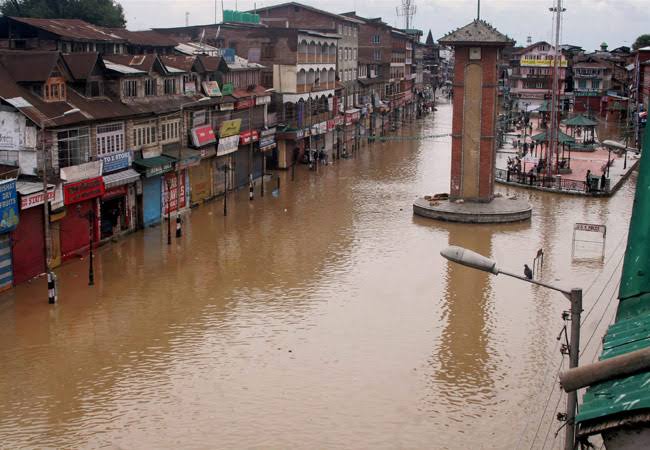Kashmir is now nearing the eighth anniversary of the devastating floods of 2014, when hundreds of residential neighbourhoods, villages and the commercial nerve centers of the region were inundated like never before in recent memory.
No matter how many anniversaries of this deluge go by, it still remains like a scar on our collective memory. The way the deluge unfolded and the scale of misery and devastation that it brought along was of a mammoth proportion. Every family was touched, every house impacted.
With the kind of freak weather events happening in the region in recent years, it becomes all the more important for everyone to recollect what happened that summer and know what could have been prevented.
It all began as a very usual affair. First it began to rain and everyone appeared to enjoy a break from the summer’s heat. The first day of rain turned into the second and then third and fourth. There were few pauses, but largely it rained every single day. By the fourth day, relatively obscure villages of south Kashmir which are nestled on the banks of glacial streams like Veshow and Rambiar faced the first brunt.
As the heavy volume of mountain rain sped into these streams, they swelled like monsters. For people everywhere else, mainly in Srinagar, it all still seemed like a distant affair. The events were happening in faraway villages, elsewhere the routine of life was normal. The accessibility to some parts of south Kashmir soon became impossible as flash floods eroded roads and pathways.
Inside the Srinagar Meteorological Centre, the weathermen observing the storms were tense but could do nothing. Three storms had gathered over Kashmir. A strong Western Disturbance from Mediterranean Sea which brought bulk of the moisture, a cyclonic storm from the Arabian sea which brought additional moisture, and a retreating monsoon storm from the Bay of Bengal which brought some more moisture.
The weathermen were also observing the build-up of unrelenting high-pressure over the Tibetan plateau, which had forced the three storms to a halt over Kashmir and drained all their moisture into the valley. Not a gush of wind, along with the high moisture clouds, was moving away from Kashmir.
This was the natural part of the disaster. There was, however, another aspect to the disaster. That aspect was made by us – the people and the governments – and it exacerbated the scale of devastation. We had choked most of the exits for the rainwater and Kashmir being a valley with a deep bowl had only a few of them. The widespread encroachment, specifically of the wetlands and flood basins, had cast the dye for us.
River Jehlum’s holding capacity had also alarmingly degraded as layers of silt had gathered on its bed. Its banks had also become weak, ready to crumble. Nobody had cared for its apathetic state.
The natural events, the man-made failures and the rampant corruption prevalent in the state institutions had all become factors for a tragic calamity that was unfolding in south Kashmir, and was now nearing Srinagar – a bustling and overcrowded city of 1.3 million people and the commercial heartland of Kashmir.
On September 7, 2014, the clock of fate finally stopped for Srinagar as the waters – which had laid waste to the parts of south Kashmir – finally reached the capital’s boundaries. A humongous volume of rainwater entered Srinagar through a narrow passage of Jehlum and soon the river banks cracked and crumbled at some places and overflew at others. By evening of September 7, Srinagar had fallen quiet.
The city, which is at a low depth of Kashmir’s bowl shaped geography, had turned into a large swamp and all access to modern life was gone. The government and all its machinery had also gone missing.
During those catastrophic times, it was the people who saved themselves. A rudimentary network of local charities rose to the task of rescue and relief and did a great service in evacuating the hospitals, saving the inundated and providing first-aid and food.
What also saved Kashmir from large-scale deaths was the centuries-old tradition of maintaining large stocks of food to outlive the harsh winters. This habit became a lifesaver and prevented families from taking risk of leaving the safety of their houses.
While Kashmir lived through the devastation of September 2014, despite the enormous economic losses, many lessons have not been learnt; some lessons have already been forgotten.
The mere tokenism of the administration to desilt the Jehlum is not enough to save Kashmir from another disaster of a similar scale. The river’s holding capacity is still abysmal for a large and sudden flow of water. The government needs to think about the alternate flood channel, long ago proposed by the Flood Control Department, which could circumvent the flood water around the Srinagar city. The 80-km spill channel from Dogripora in south Kashmir to Wular lake in north Kashmir is the only long-term and effective measure against any future flood.
Similarly, the wetlands and flood basins of the past have been turned into residential neighbourhoods and, also, with the government’s infrastructure. Of the city’s total land area of 766 sq. km., 157 sq. km designated in Srinagar Master Plan 2035 as ecologically fragile and 107 sq. km is of medium to high vulnerability to floods – which makes 57 percent of Srinagar not feasible for any development.
Yet, there are no lessons learnt from the near past. Srinagar continues to grow into an urban mess with continuing large scale construction and filling up of traditional wetlands and flood basins: a perfect case for another disaster.
With the impact of climate change becoming more and more imminent and freak weather events becoming more common in Kashmir, like a snowless winter this year, or a blistering hot spring, or the June snowfall, we should be asking ourselves the question that needs to be answered. Are we ready for another disaster?


